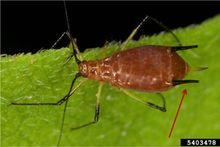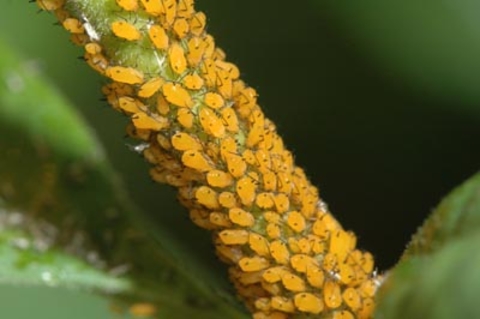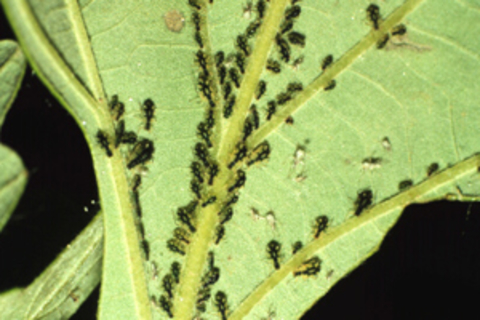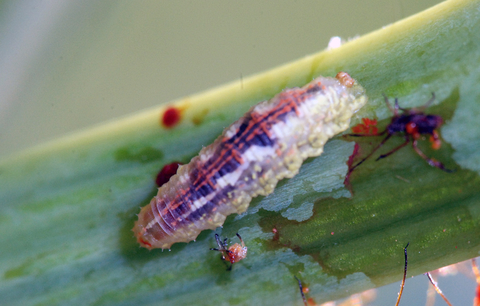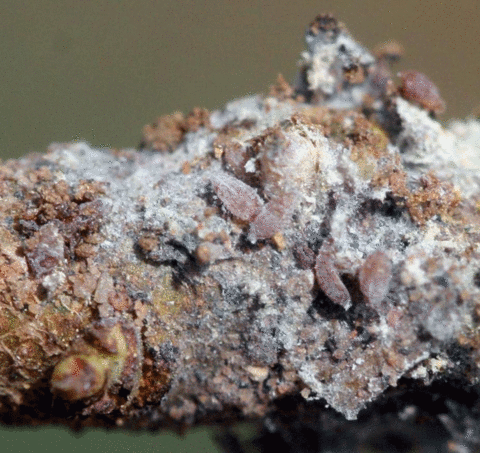Quick facts
-
Aphids are very common insects and are found on most plants in yards and gardens.
-
In most cases they cause little or no damage to the health of plants.
-
Signs of severe aphid feeding are twisted and curled leaves, yellowed leaves, stunted or dead shoots and poor plant growth.
-
Treating aphids for the health of plants is usually unnecessary.
-
Aphids can often be managed with only non-chemical options or low risk pesticides.
How to identify aphids
Aphids are small, 1/16- to 1/8-inch-long (2-4 mm), pear-shaped, soft-bodied insects. They can range in color from green, black, red, yellow, brown or gray.
Mature aphids can be wingless or can have wings.
Winged aphids are similar in color but are a little darker.
Immature aphids (nymphs) look like adults but are smaller.
The best way to identify aphids is to check for two tail pipes (cornicles) found at the end of the abdomen. All aphids have cornicles, but some are smaller and less obvious.
Aphids shed their exoskeletons (skins) as they grow. These white cast skins can be found on leaves or stuck in honeydew secretions of the aphid.
The life cycle of aphids is complex and varies with each species. The cabbage aphid is a good example of a typical life cycle.
Female aphids do not need a male to reproduce. For most of the summer, wingless females give birth to live young instead of laying eggs. Cabbage aphids can complete up to 15 generations per season because they mature quickly and can reproduce throughout their lifespan.
In response to crowding by other aphids or declining host plant quality, winged (migratory) forms are produced that move to new plant hosts. They are poor fliers but can travel for miles with the wind because of their small size.
In the fall, male nymphs are produced that mature and mate with females.
- Females lay eggs that live through the winter on the plant.
- In the spring, the eggs hatch and new female aphids feed and reproduce.
Common aphids in Minnesota
Green peach aphids feed on hundreds of different plants including potato, pepper, cabbage, spinach, asparagus, aster, dahlia, iris and verbena. They are commonly found on cabbage but do not cause serious damage.
They are yellowish-green and have long cornicles. The eggs can live through the winter.
Cabbage aphids feed only on cruciferous plants like cabbage and mustard. They are green with a waxy covering that gives them a grayish-white appearance. They have short cornicles and feed on the underside of leaves in large clusters, in the center of cabbage heads or on the youngest leaves.
Adults are present in both wingless and winged form. You are most likely to see wingless females that produce live young (nymphs).
Potato aphids commonly infest potatoes, tomatoes and other solanaceous crops, such as peppers, eggplant and morning glory.
Melon aphids feed on a variety of plants, especially cucurbits such as watermelons and cucumbers, as well as asparagus, pepper, eggplant, aster, hollyhock and lily.
Brown ambrosia aphids are common on Rudbeckia, coneflower and sunflower.
Oleander aphids feed on milkweed throughout the spring and summer but do not cause any damage to plants.
They are 1/8 inch long, pear-shaped and bright yellow with black legs, long antennae and two black tail pipes at the end of the abdomen.
Aphids of landscape plants will feed only on a specific tree or shrub and will not attack any other type of plant. For example, aphids infesting a quaking aspen would not attack an oak tree.
The most commonly found aphids in Minnesota landscapes are found on roses, spirea, poplar (aspen and white poplar), willows, oaks, maples, white pine, lindens and fruit trees (especially apples and crabapples).
Damage caused by aphids
Aphids use slender needle-like mouthparts to feed on sap from plants. They gather where they can feed on new succulent growth on unopened flower buds, the underside of young leaves and developing stems, twigs, bark and roots.
In many cases, there are no visible symptoms of aphid feeding. Symptoms of severe aphid feeding are:
- Twisted and curled leaves
- Yellowed foliage
- Stunted or dead shoots
- Poor plant growth
When aphids feed, they inject saliva into their host plant to help digest the sap. After feeding, they secrete a sticky, shiny waste product called honeydew.
Honeydew is a sugar-rich material that attracts ants, yellowjackets (especially during late summer and fall) and other insects that feed on it.
It can coat bark, leaves and objects beneath the plant, including car windshields and lawn furniture, leaving a sticky mess.
Honeydew generally does not cause any harm, but can cause leaves to stick together and can encourage the growth of sooty mold.
Sooty mold is a fungus that grows on honeydew and is often found on trees with aphids.
The fungus is not harmful to the tree, but can cause dark, fuzzy splotches on leaves and branches.
How to remove honeydew
Removing honeydew from plants is not necessary as it does not harm plants.
If honeydew is a major problem, treatment should be applied after the leaves have started forming (or when honeydew is noticed) to kill the aphids and reduce honeydew problems.
Dish detergents and tar removers can be used to remove honeydew from structures and vehicles.
You will need to scrub with a washcloth or sponge.
Tar removers and heavy duty dishwashing detergents may damage painted surfaces and remove the clear coating from cars.
Test it on a small portion of the surface to make sure it does not cause more damage.
Aphids can carry several different plant viruses, including cucumber mosaic virus. This virus can infect many vegetables including squash, cucumber, pumpkin, melon, beans, spinach, tomato, lettuce and beets as well as annuals and perennials such as impatiens, gladiolus, petunia, phlox and rudbeckia.
Viruses can cause leaves to mottle, yellow or curl.
Plant growth may be stunted.
In some cases fruit can be misshapen.
How to protect your plants from aphids
Check plants for aphids regularly throughout the growing season. Because aphid populations can explode, it is important to monitor plants as often as possible. Carefully check leaves and stems for the presence of aphids.
Remove weeds from your garden to reduce potential sites for aphid attack. Weeds such as sowthistle and mustard can support large numbers of aphids.
You can physically knock aphids off plants with a strong spray of water from a garden hose. This will also help wash off any honeydew or sooty mold that may be present.
Aphids are not strong insects and even a good rainstorm can knock them off. You may notice more aphids in seasons with lighter rain.
There are many natural enemies of aphids that are commonly found in gardens, including lady beetles, lacewings, syrphid fly larvae and parasitic wasps. Because aphids can multiply very fast, it will likely take some time for the predator insects to catch up and reduce aphid numbers.
Protect natural enemies by avoiding pesticide applications or using low risk products. Encourage natural enemies by planting flowering plants that blossom at different times of the growing season.
In most cases, aphids cause little to no damage to plants and can be ignored. If aphids are causing problems, and it is necessary to treat them, you may want to consider using insecticides.
Low risk pesticides
Several insecticides are low risk to people, beneficial insecticides and the environment.
Neem (azadirachtin) is a plant based pesticide that discourages aphid feeding. Insects are not killed quickly, but it makes them stop feeding and they slowly die.
Insecticidal soap, horticultural oil and pyrethrins can be effective at controlling aphids.
- Remember to spray the underside of leaves as well as the top.
- These materials will only kill aphids that they come in contact with. Repeat applications may be needed.
Residual pesticides
These products are effective for one week or more. While they are longer lasting, they also kill a variety of insects, including natural enemies. This can make aphid problems worse. Do not spray trees or shrubs that are blooming.
Common examples of pesticides available to consumers include acephate, permethrin, bifenthrin, lambda-cyhalothrin, cyfluthrin and malathion.
Systemic pesticides
Systemic products, like imidacloprid and dinotefuran, are applied to the base of trees and transported through the sap to the leaves, stems and branches where the aphids are feeding. When the aphids consume the pesticide they will die.
This process can take between two to four weeks depending on the product used and the size of the tree. Most of these products will also kill other insects feeding on foliage in trees. The use of systemic insecticides avoid pesticide drift, especially when treating large trees.
Systemic pesticides don't directly contact natural enemies. However, imidacloprid and dinotefuran are very toxic to pollinators. Either avoid applying these insecticides to bee attractive plants or wait until the plants have finished blooming before treating them.
Professional services
You can also hire a professional landscape company to treat aphids on trees and shrubs. They have the training and experience to successfully manage an aphid problem. See How to hire a tree care professional.
CAUTION: Read all pesticide label directions very carefully before buying and again before using to ensure proper application. Be sure that the label specifies it can be used on the specific plant you wish to treat. The label is the final authority on how you may legally use any pesticide.
Whenever using any pesticide, including low impact, natural or organic pesticides, follow all label directions and use standard pesticide safety practices for transporting, storing, mixing, applying and disposing of pesticides to protect yourself, your neighbors and the environment.
Woolly aphids
Woolly aphids are found on trees and shrubs.
They are similar to true aphids, but have white waxy strands covering their pear-shaped bodies.
The wax filaments make these aphids look fluffy and cottony, as if they are covered with wool. The wax also keeps predators away from these aphids and helps them move easily around plant hairs.
Woolly aphids usually alternate feeding between two different host plants (some feed on just one host plant).
- They lay eggs on the primary host plant.
- The eggs live through the winter and female aphids hatch from the eggs during spring.
- On the same plant, females begin producing live offspring, without mating.
- The aphids are clones of the female aphids that laid the eggs.
After one to two generations on the primary host, the new aphids will develop wings when they reach adulthood. Winged female aphids will fly to a secondary host plant and begin feeding and reproducing.
- Woolly aphids spend most of the growing season on their secondary host.
- Each female produces hundreds of offspring over several generations.
- The average lifespan of an aphid is approximately one month.
- They reach sexual maturity in four to ten days and then are able to produce their own offspring.
In late summer or early fall, another generation of winged females is produced on the secondary hosts. The females then fly back to the primary host.
- Here, the winged aphids produce males and females.
- These aphids mate and females lay eggs.
- The eggs from this generation will live through the winter and start the cycle again in the spring.
Woolly aphids feed on plant sap with their needle-like mouthparts. They can feed on leaves, buds, twigs, bark and even roots.
Symptoms of feeding:
- Twisted and curled leaves
- Yellowed foliage
- Poor plant growth
- Low plant vigor
Also watch for accumulations waxy material and shed skins on leaves, twigs and bark.
Woolly aphids produce large amounts of honeydew (see Damage caused by aphids in the main section), which covers leaves and branches as well anything underneath infestations.
Fortunately, woolly aphids damage mostly just affects a plant’s appearance. It rarely affect plant health.
Many woolly aphid species are found on deciduous trees and shrubs in Minnesota.
Woolly elm aphids
(Eriosoma americanum)
- Attack American elm in the spring, which results in curled leaves with white cotton-like masses inside them.
- These aphids move to serviceberry shrubs in early summer.
- In early fall they fly back to elm to spend the winter.
- They do not cause major damage to mature trees and shrubs.
- They can be damaging when found in large numbers on serviceberry shrubs younger than three years old.
Woolly alder aphid or Maple blight aphid
(Prociphilus tessellates)
- Form dense, white, woolly masses on the leaves and twigs of silver maple in early spring, and on alder twigs and branches in the summer.
- When maple leaves are severely affected, the leaves fold lengthwise and cover the aphids inside.
- The white, waxy threads do not cause any damage, but can be mistaken for a fungus.
- In the fall, the aphids produce males and females that mate and lay eggs on the maples.
- These eggs, and in some cases nymphs (young aphids), can live through the winter on branches of the alder tree.
Leafcurl ash aphids
(Prociphilus fraxinifolli)
- Feed on emerging ash leaves in the spring, causing them to be distorted.
- Feeding lasts until mid-summer.
- Winged forms then move to ash roots where they remain for the rest of the year.
- Leafcurl ash aphids cause little, if any, damage to ash.
In most cases, management is not necessary for the health of trees and shrubs, especially large mature plants.
Similar to other aphids, natural enemies (lacewings, lady beetles, hover flies and parasitic wasps) help keep woolly aphid numbers low.
Woolly aphids are not affected by horticultural oils and soaps, like other aphids. This is because the waxy secretions of the woolly aphids and the distorted leaves do not allow the pesticide to enter the leaves.
Contact pesticides, like permethrin, also do not work on woolly aphids for the same reason.
In cases where management is necessary to protect plants, systemic pesticides, like imidacloprid and dinotefuran, are the most effective against woolly aphids. However, imidacloprid and dinotefuran are very toxic to pollinators. Either avoid applying these insecticides to bee attractive plants or wait until the plants have finished blooming before treating them.
Consider hiring a professional landscape company to treat your trees or shrubs.
Reviewed in 2019



